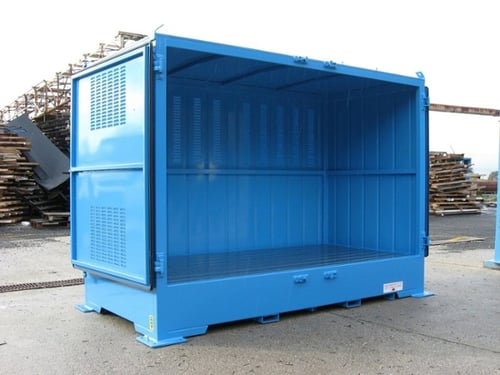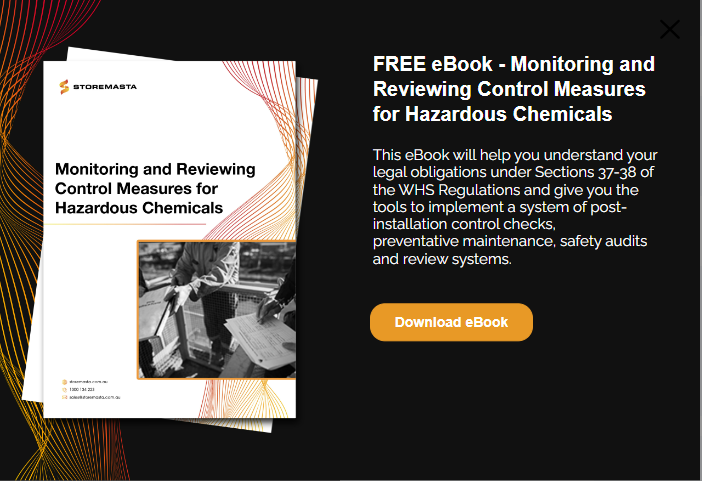So, you’ve recently selected an outdoor chemical store to house your Class 3 Flammable Liquids? This blog is designed to take you through the next steps of installing and maintaining your flammable liquids storage container. We’ll be looking at the installation and maintenance requirements for flammable liquids outdoor stores as per the Australian Standards. We’ll also be explaining further safety measures you may need to consider to ensure your chemical container stays compliant.
Flammable Liquids Storage Container
If your business is carrying large quantities of Class 3 Flammable Liquids, you’ve probably opted for a relocatable outdoor store for your hazardous chemicals. However, choosing a compliant chemical storage container is only the first step in achieving compliance under WHS Regulations.
The Australian Standard that relates to this class of dangerous goods is AS 1940:2017- The storage and handling of flammable and combustible liquids. This document offers a highly detailed explanation of the many steps organisations must take to ensure that they reduce risk when handling and storing flammable liquids. While the WHS Regulations provides a broad overview of your safety and compliance obligations, the Standard offers specific requirements that relate to your outdoor stores of Class 3 liquids.
Based on these requirements, as well as our own recommendations, this blog will be looking at the following considerations for the installation and maintenance of your flammable store:
- Chemical segregation
- Separation from protected places
- Isolation from ignition sources
- Security for outdoor chemical stores
- Secondary spill containment
- Anchoring the store
- Essential documents
- Signage
- Emergency decontamination
- Maintaining the store
- Housekeeping practices
Keep reading to learn more about these specific chemical compliance considerations in the next section of our blog.
IMPORTANT: Your flammable liquids storage container should be manufactured in full conformance with Australian Standards, with adequate spill containment, vapour containment, self-closing, tight-fitting doors and non-combustible materials for the construction.
Chemical Segregation
Almost all dangerous goods must be separated from other chemical classes due to incompatibility. Flammable liquids are a particularly volatile substance which must be segregated from all other classes of dangerous goods.
When storing multiple DG classes at your worksite, make sure you refer to the dangerous goods segregation chart. The segregation requirements include detailed information about the distances needed between stores of incompatible chemicals. Never store or handle flammable liquids with any other class of dangerous goods, and always refer to the individual Safety Data Sheet (SDS) of the product you’re storing, to make sure you’re meeting all the chemical segregation requirements.
Separation From Protected & Public Places
Because flammable liquids pose the risk of fire, explosion, human harm and environmental contamination, your outdoor store must be separated from protected places and public places.
A protected place refers to a variety of dwellings, buildings, areas or facilities that may be within or outside the property boundary of your store. Protected places include schools, theatres, hospitals, residential buildings, dwellings, offices and shops. Public places, on the other hand, are any places that are open to the public, other than private properties.
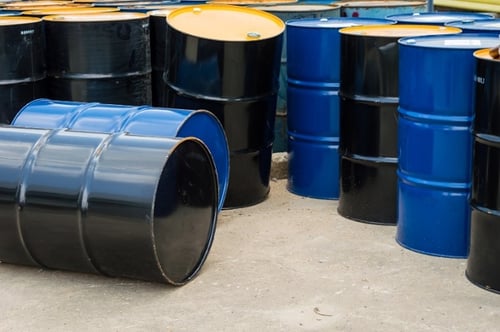
Refer to the Australian Standards to determine how you should store your flammable liquids and how far they should be from protected places.
For flammable liquids, the Standard explains that your store should be located away from protected places and public places by a specific distance. This distance is determined by the packing group of the flammable liquids that you are holding. For example, if you’re storing 1m3 (kL) of flammable liquids from PG I or PG II, then you will have to distance your store from protected places by a distance of 3 metres. You must also separate the store from public places by a distance of 3 metres (if packages remain closed) or 8 metres (if packages are opened).
Refer to the Standard to learn more about the separation requirements that relate to your specific operations.
Isolation From Ignition Sources
For any organisation that carries Class 3 Flammable Liquids, the education of staff about the hazards associated with ignition sources is a vital part of staff training. Flammable liquids should never come within 3 metres of an ignition source, whether it’s a power point, welding equipment or a hot surface.
When you’re selecting a location for your flammable liquids storage container, make sure you correctly identify any ignition sources in the area and install your cabinet at least 3 metres away from these sources. Place the appropriate hazard signage on your store to warn staff not to bring any ignition sources (such as a lit cigarette) within the general area of your chemical store.
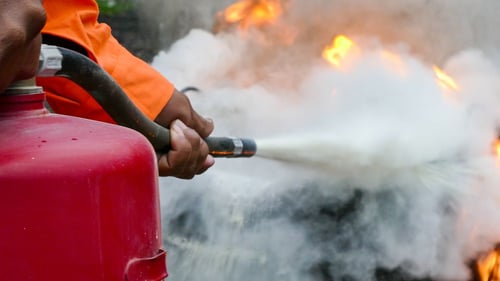
To prevent fire, ensure that your flammable liquids storage container is located at least 3 metres away from any type of ignition source.
Security For Outdoor Chemical Stores
Being in the outdoor environment, it’s important that you protect your business from the hazards associated with unathorised entry of your chemical stores. While all compliant flammable liquids storage containers are equipped with security features, such as ISO locking bars, it’s vitally important that your staff are vigilant with securing the container after it’s been in use.
Unauthorised entry to your outdoor flammable liquids store could result in chemicals being stolen, lost or misused. Not only is there the financial cost of the chemicals going missing, but there is a real risk of those chemicals falling into untrained hands who may cause an incident such as a chemical spill or fire. Creating procedures and training to ensure your outdoor store is always secured is an important risk control measure for any business that stores flammables outdoors.
Secondary Spill Containment
While your flammable liquids storage container is already equipped with a spill containment system with a compliant capacity, you may wish to create a further secondary spill containment solution for your outdoor chemical handling and storage areas.
There are a vast range of bunding products on the market, including floor bunding, flammable liquids drum handling equipment and bunded fuel decanting systems for organisations that handle petrol or diesel. Depending on the work practices that your staff must tend to on a regular basis, you can provide additional bunding to prevent chemical leaks and spills entering your workplace and the surrounding environment.
REMEMBER: Flammable liquids can ignite if vapours meet an ignition source. These hazardous vapours can quickly spread through a workplace and cause human harm as well as fires and explosions. As chemical spill containment is a key issue in flammable liquids safety, we suggest conducting an onsite risk assessment to properly determine your bunding needs.
Anchoring The Store
We recommend anchoring an outdoor flammable liquids store to provide extra stability and protection for your chemical packages — and protection for the store itself. While AS 1940:2017 does not require outdoor stores to be anchored, it’s a good idea to anchor the store to reduce risk.
There are many things that can occur in the outdoor environment which could affect the condition and safety of your chemical store.
These may include:
- Cyclones and strong winds
- Fallen branches
- Debris from storms
- Vehicle and equipment impact
- Attempted vandalism or theft
Our range of Class 3 Flammable Liquids storage containers are already equipped with base plates. The containers can be easily bolted down and anchored to the spot once you’ve determined the correct outdoor location for your chemical store.
Anchoring your outdoor chemical store provides protection against instability and impact damage.
Essential Documents
Regardless of how large your store is or what type of chemical you’re storing, it’s important to keep your SDS and other essential documents in a safe and secure place. In the event of a chemical spill or emergency, these documents must be readily available to staff and emergency crews that access your site.
You’re legally required to provide the SDS for each chemical product, so they can be correctly identified. You’re also obliged to provide a hazardous chemicals register which should include a full list of hazardous chemicals and their SDSs.
REMEMBER: In addition to the SDS and hazardous chemical register, all your flammable liquids chemical containers should be correctly labelled. This also includes any portable containers that your staff may use for chemical transferral or decanting.
Signage
Your flammable liquids store must always be clearly marked with well-maintained dangerous goods and hazard signage. For Class 3 Flammable Liquids, you are required to have the following signage:
- The Class 3 Flammable Liquids diamond
- No smoking, no ignition sources within 3 metres
If you notice that your signage is deteriorating or has gone missing, it’s part of your compliance obligations to have the signage immediately replaced with the appropriate DG diamond and safety signs.
Emergency Decontamination
Eyewash facilities are required for outdoor flammable liquids stores, so staff can quickly decontaminate their face and eyes if a chemical is splashed or spilt. Your eyewash facilities should be installed between 2 metres and 10 metres from your flammable store.
There are also certain requirements that relate to the provision of a safety shower on site, however, this is only applicable for stores with a specific flammable liquids capacity. As with the eyewash facilities, all safety showers must be located within easy reach of the store (2 – 10 metres away).
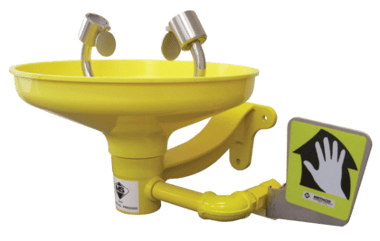
Your store should be equipped with a compliant eyewash facility for emergency decontamination of your staff.
Maintaining The Store
Just like any piece of risk control equipment, your store must be properly maintained to provide the highest standards of safety for your organisation. If stores suffer impact damage, vandalism or they haven’t been equipped with the right level of corrosion-protection, they will not be able to provide adequate protection.
You should develop a regular inspection and maintenance routine for your chemical stores, so that any issues are quickly noted and rectified. Staff should be on the look out for:
- Deterioration of signage
- Any dents or chips
- Signs of corrosion
This inspection routine can also include the monitoring of your flammable liquids store housekeeping practices.
/How%20to%20store%20hazardous%20chemicals%20legally%20and%20safely-703474-edited.jpg?width=500&name=How%20to%20store%20hazardous%20chemicals%20legally%20and%20safely-703474-edited.jpg)
It’s important to maintain your chemical store so it continues to provide the highest levels of protection for your business.
Housekeeping Practices
Good housekeeping practices are essential for eliminating risks such as hazardous vapours and fires. While your flammable liquids storage container is equipped with a spill containment system, this must be regularly inspected and cleaned-out if you are to remain compliant.
Housekeeping practices should also include the correct stacking and loading practices for your flammable chemical containers. Make sure that drums are only stacked 3 high, and keep your shelves clean and organised to prevent containers from becoming unstable and falling.
REMEMBER: If your chemical storage container is not suiting your exact stacking and loading needs, consider opting for customisable shelving and racking which fits the requirements of your daily operations.
Maintaining Compliance With Flammable Liquids Stores
As we’ve detailed in this blog, there are a wide range of considerations when installing and maintain your flammable liquids outdoor storage container. Just like any type of dangerous goods or hazardous chemicals, it’s important that you adhere to WHS Regulations and follow the detailed requirements of the Australian Standards. Factors including the location, maintenance and housekeeping of your store can affect the compliance and safety of your storage solutions.
If you’d like to learn more about remaining compliant, we have an eBook that can help. Our guide will introduce you to our simple 4-step risk control methodology and offer helpful tips on how to care for your chemical storage equipment. Grab your copy for free today by simply clicking on the image below.
Joining the team as a Dangerous Goods Storage Consultant, Melissa Hampton became Storemasta's Marketing Manager in late 2021. With extensive knowledge and experience in chemical compliance, Melissa is responsible for leading the Marketing team and helping shape their marketing strategy. In her spare time, you can find Melissa hiking, swimming and enjoying the great outdoors in beautiful north-west Tasmania.

